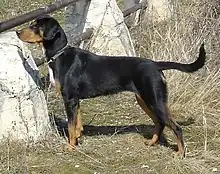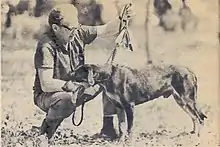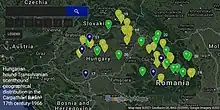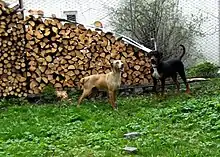Transylvanian Hound
The Transylvanian Hound (Hungarian: erdélyi kopó [ˈɛrdeːji kopoː]; Romanian: copoi ardelenesc Romanian pronunciation: [ko'poj ardele'nesk]; also known as the Transylvanian Scent Hound or Hungarian Hound)[1] is a dog breed originating from Hungary and Transylvania (Transylvania was part the Kingdom of Hungary-nowadays Romania) and was historically primarily used for hunting. It is a strong, medium-sized scent hound, characterized by a black body, with tan and sometimes white markings on the muzzle, chest and extremities, and distinctive tan eyebrow spots. It has a high-pitched bark for a dog of its size. The breed was rescued from extinction by focused breeding efforts in the late 20th century. There were formerly two varieties, the tall and the short, developed for different kinds of hunting in the Middle Ages. Only the tall variety survives today.[1]
| Transylvanian Hound | |||||||||||||||||||||
|---|---|---|---|---|---|---|---|---|---|---|---|---|---|---|---|---|---|---|---|---|---|
 | |||||||||||||||||||||
| Other names | Transylvanian Scent Hound Hungarian Hound erdélyi kopó copoi ardelenesc | ||||||||||||||||||||
| Origin | Hungary | ||||||||||||||||||||
| |||||||||||||||||||||
| |||||||||||||||||||||
| Dog (domestic dog) | |||||||||||||||||||||
History
It is claimed the Transylvanian Hound descends from hounds brought by the Magyars when they crossed the Carpathian Mountains in the ninth century and bred with those already found in the area, with the resultant progeny becoming the foundation stock for the breed.[2] In the Middle Ages the dog was the favourite of the Hungarian aristocracy for hunting various game animals.[1] Two height varieties developed to hunt different game in different types of terrain, and both varieties were kept together.[1]
_kop%C3%B3val%252C_Hajd%C3%BAhadh%C3%A1z.jpg.webp)
The tall variety was used for hunting woodland and grassland big game, such as European bison, bear, boar, and lynx.[1] The short variety was used for hunting fox, hare, and chamois in overgrown or rocky terrain.[1] The breed declined and was marginalised to the Carpathian woodlands, shrinking with the growth of agriculture and forestry, and by the beginning of the twentieth century it was nearly extinct.[1] It was almost wiped out during the Second World War and in 1947, after Transylvania again became fully part of Romania, the Romanian government exterminated those that had survived in to remove the reminder of the Hungarian occupation.[3][4] Some survived in Hungary and Slovakia, where breeders are working to revive the breed.[3][5]
In 1886 the first official registration of the breed began with the "Hungarian Hunting Dog Pedigree" (Magyar Vadászeb Törzskönyv).[6] In 1941 the breed was registered as a Hungarian Hound by the Hungarian National Vizsla Club/Hound Division (Magyar Országos Vizsla Klub/Kopó szakosztály) and recovery of the breed started with 27 individuals; the Second World War puit an end to this. A further recovery operation began in the 1960s.[7]

The breed was recognised and standardised by the Fédération Cynologique Internationale in 1963, with definitive acceptance on 30 March in that year.[8] In 1968 further efforts began to recover it.[1] In the twenty-first century, substantial numbers of the tall variety of the dogs may be found in both Hungary and Romania.[1]
The Transylvanian Hound is, naturally, recognised by the national dog breeding and fancier group, the Hungarian Kennel Club (using the FCI breed standard).[9]

Description

There are two size variants of the Transylvanian Hound, comes in two sizes although the FCI breed standard only describes the long-legged variety. The short-legged variety typically stands between 46 and 51 cm (18 and 20 in) and the long-legged variety between 56 and 66 cm (22 and 26 in).[1][3][4][10][11] The short-legged variety typically weighs between 22 and 25 kg (49 and 55 lb), the long-legged variety some 30–35 kg (66–77 lb).[3][10] It has a typical scent hound head, long but not pointed and free from wrinkles; the ears are medium-sized and pendent, wide in the middle and tapering to a rounded tip.[3][10] The body is relatively long but square, the chest broad and long but not overly deep; the low-set tail is kept undocked, and when hunting is typically carried curled at the level of the back.[10] The coat is short, straight and close fitting, slightly longer in the long-legged variety than in the short. The short-legged variety is usually dark red and tan or dark red and tan tricolour (dark red, tan and white) in colour, while the long-legged variety is usually black and tan or black and tan tricolour (black, tan and white).[4][10]
The continental climate of its native land, with its hot summers and cold winters with heavy snow falls, has resulted in a breed with great stamina as well as a very keen and reliable scenting ability.[10][2]
The Transylvanian Hound is usually obedient, good natured, tolerant of children and easy to train; as a pack hound it is very friendly with other dogs.[4][10][2][12] It is described as being reserved, slightly suspicious and introspective in character; when hunting it shows courage and a good sense of orientation.[3][10][2][12]
References
- "FCI-Standard N° 241: Erdélyi Kopó – Hungarian Hound – Transylvanian Scent Hound" (PDF). Fédération Cynologique Internationale. Thuin, Belgium. 13 September 2000. Retrieved 4 February 2021.
- Alderton, David (2000). Hounds of the world. Shrewsbury: Swan Hill Press. p. 113. ISBN 1-85310-912-6.
- Fogle, Bruce (2009). The encyclopedia of the dog. New York: DK Publishing. p. 192. ISBN 978-0-7566-6004-8.
- Morris, Desmond (2001). Dogs: the ultimate dictionary of over 1,000 dog breeds. North Pomfret, VT: Trafalgar Square Publishing. pp. 109–110. ISBN 1-57076-219-8.
- Tőkés Lóránt, Pelczéder Tibor: Az Erdélyi kopó történelméhez, in. Az erdélyi kopóról, 21. oldal, Budapest, 2021
- Vadász és Versenylap, Budapest, 1879
- Dr. Tóth Zoltán: Az erdélyi kopó in. Hunor vadászkönyv 185
- "FCI breeds nomenclature: Erdélyi Kopó (241)". Fédération Cynologique Internationale. Thuin, Belgium. Retrieved 2 March 2015.
- "Erdélyi Kopó". KennelClub.hu. Budapest: Magyar Ebtenyésztők Országos Egyesülete [Hungarian Kennel Club]. 2013. Archived from the original on 9 September 2013. Retrieved 2 March 2013.
- Fiorone, Fiorenzo (1973). The encyclopedia of dogs: the canine breeds. New York: Thomas Y. Cromwell Company. p. 198. ISBN 0-690-00056-1.
- Hancock, David (2014). Hounds: hunting by scent. Ramsbury, Marlborough: The Crowood Press Ltd. p. 169. ISBN 978-1-84797-601-7.
- Alderton, David (2008). The encyclopedia of dogs. Bath: Parragon Books Ltd. p. 224. ISBN 978-1-4454-0853-8.